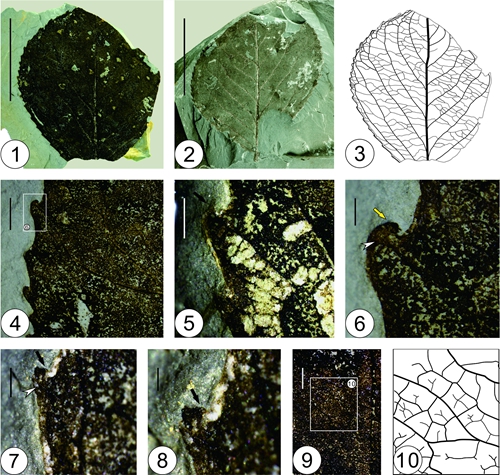Celastrus L. is a deciduous or evergreen woody vine.The genus is characterized by a hardy stem with orbicular to ovate lenticels, alternate simple leaves with serrate or subentire margin. The genus was revised into two subgenera with two series, namely subgenus Celastrus with series Paniculati (seven species) and series Axillares (17 species). Many fossils referred to the genus have been found in the Cretaceous of North America and the Cenozoic of North America, Europe, Asia and Australia. However, those fossil leaves with theoid teeth having deciduous setae are less common.
Prof. ZHOU Zhekun and his team of Xishuangbanna Tropical Botanical Garden (XTBG) found compressed and fossil leaves of Celastrus in Sanzhangtian (24°06′ N, 101°13′ E) , Zhenyuan, Yunnan, China. Fossil leaves from the middle Miocene of Zhenyuan were pinnate and petiolate, and had semicraspedodromous secondary veins with apically elongated arches and theoid teeth with a clear, deciduous seta.
The researchers observed and photographed the fossil leaves with a Nikon D700 camera and a stereo microscope. They then compared the fossil leaves with specimens representing 23 extant species and one subspecies. They assigned the leaves from Zhenyuan to a new species and named it as Celastrus caducidentatus Liang XQ et ZK Zhou.
The researchers also reviewed its relationship to extant species in order to discuss its palaeobiogeographic and palaeoclimatic implications. Based on the nearest living relative approach, the presence of fossil Celastrus caducidentatus suggested that Zhenyuan had a warmer and more humid climate in the Middle Miocene and that ancestors of C. paniculatus probably occurred in East Asia. The results showed that plant migration occurred between eastern Asia and North America via transpacific dispersal in the geological past.
The study entitled “A new Celastrus species from the middle Miocene of Yunnan, China and its palaeoclimatic and palaeobiogeographic implications” has been published in Review of Palaeobotany and Palynology.
Contact
ZHOU Zhekun, Ph.D Principal Investigator
Key Laboratory of Tropical Forest Ecology, Xishuangbanna Tropical Botanical Garden, Chinese Academy of Sciences, Mengla, Yunnan 666303, China
Tel: 86-871-65109223
E-mail: zhouzk@xtbg.ac.cn 
Leaves of Celastrus caducidentatus from the middle Miocene of Zhenyuan, China (Image by LIANG Xiaoqing)
|

